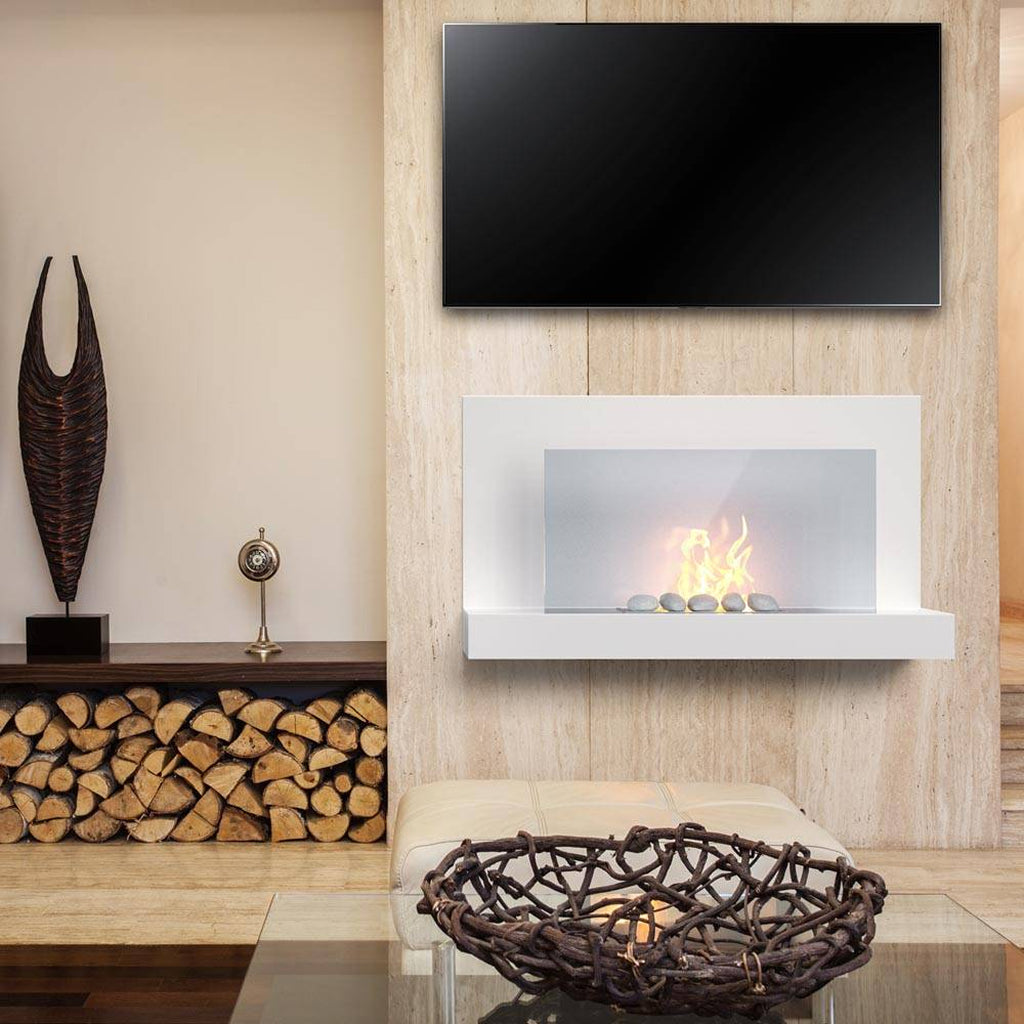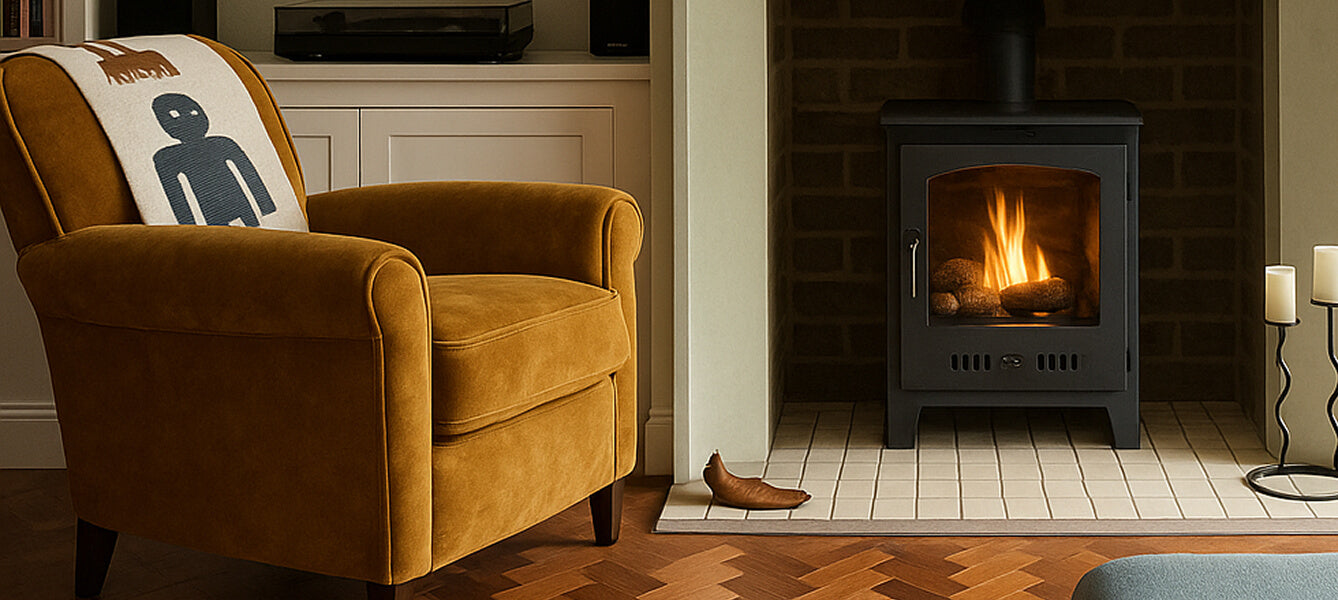
Bioethanol Fireplace Emissions: Are They Truly Clean-Burning?
Seeking a cleaner, more sustainable way to enjoy the comfort of real flames? Bioethanol fireplaces have emerged as a popular alternative to logburners in recent years, thanks to their sleek designs and eco-friendly claims.
In today’s blog, we uncover the truth behind bioethanol’s clean-burning reputation, and explore how it compares to wood and gas when it comes to emissions and carbon output.
The science behind bioethanol combustion
Bioethanol is a renewable energy source that’s made from the fermentation of crops such as corn, sugarcane, and other biomass. When burned, it produces heat, light, water vapour, and a small amount of carbon dioxide (about the same amount as burning a couple of tealights).
Unlike fossil fuels, which release carbon that’s been locked underground for millions of years, bioethanol’s carbon output is part of a much shorter, more sustainable cycle. The CO₂ released during combustion is balanced by the CO₂ absorbed by the plants used to make fuel, making it a carbon-neutral option.
This means that bioethanol combustion is actually very clean. There’s no smoke, soot, or ash to worry about, and no need for a flue or chimney to vent any harmful by-products. The result is a clean-burning flame that delivers real warmth, without the mess or environmental guilt of traditional fires.
Are bioethanol fires really emission-free?
It’s important to note that no fire can ever be entirely emission-free. Any fuel that burns will release something, including bioethanol. The key difference lies in what is released and how much.
The by-products of bioethanol are minimal – primarily water vapour and carbon dioxide in small amounts. You won’t get any harmful particulates, carcinogenic gases, or unpleasant odours that are associated with wood or gas fires.
We describe our bioethanol fireplaces as clean-burning. They’re not emission-free, but their combustion process is clean. In fact, the process produces the same natural elements you exhale when breathing. This is why our bioethanol fireplaces can operate safely indoors without a flue (unless you purchase one of our false flues, of course!).
How does bioethanol affect indoor air quality?
If you’re considering a vent-free bioethanol fireplace, you’re probably wondering about how it will impact the air quality inside your home.
Because they don’t produce any smoke or harmful toxins, bioethanol fires have minimal impact on indoor air quality. But as you would with any open flame, we highly recommend ventilating your room regularly. Opening a window slightly and ensuring the room isn’t completely sealed will allow fresh air to circulate around the space and prevent the build-up of CO₂.
All our biofires are specifically designed to operate safely in well-ventilated spaces. But if you’re still concerned about health and safety, check out our top 5 bioethanol fireplace safety tips for families.
How bioethanol compares to wood and gas fires
The differences are striking when you compare bioethanol fireplace emissions with other heating options like wood and gas.
When wood burns, it releases smoke, fine particulates (PM2.5), and compounds like carbon monoxide, which can negatively affect both indoor and outdoor air quality. Even the most efficient woodburning stoves still produce pollutants that need to be vented outdoors.
Gas fires do burn cleaner than wood, but they still rely on fossil fuels and can emit gases like nitrogen dioxide (NO₂) and carbon monoxide (CO). These gases can contribute to poor air quality and are harmful to both human and environmental health.
Bioethanol fires, however, are the ultimate clean-burning option. They burn a renewable, plant-based fuel that emits no soot, no smoke, and no harmful gases. The only outputs are heat, water vapour, and trace amounts of CO₂ – a fraction of what’s produced by traditional fireplaces. That’s why they’re often described as providing clean heat i.e. warmth you can feel good about, that’s beneficial for both your home and the planet.
|
Feature |
Bioethanol fireplaces |
Woodburning fireplaces |
Gas fireplaces |
|
Fuel source |
Renewable (plant-based ethanol) |
Non-renewable (wood logs) |
Fossil fuel (natural gas or LPG) |
|
Main emissions |
Water vapour and trace amounts of CO₂ |
Smoke, soot, particulates, and CO₂ |
CO₂, NO₂, and CO |
|
Air quality impact |
Minimal – safe to use indoors with ventilation |
Poor – releases harmful particulates |
Moderate – emits gases that can affect indoor air quality |
|
Ventilation needed |
Basic air circulation |
Chimney or flue needed |
Vent or flue recommended |
|
Residue/smell |
None |
Ash, soot, and smoke odour |
Mild gas smell possible |
|
Carbon output |
Low – part of a short carbon cycle |
High – releases stored carbon when burning |
Medium – fossil-based fuel |
The final verdict
So, are bioethanol fires truly clean-burning? Absolutely. While no flame is completely emission-free, bioethanol’s clean combustion and low carbon output make it one of the most eco-friendly ways to experience real firelight indoors.
Bring clean-burning flames into your home with imaginfires
At imaginfires, we believe that being able to enjoy the beauty of real flames shouldn’t come at the expense of the planet. We offer a wide range of bioethanol fireplaces that are completely clean-burning and safe for indoor use, helping you bring real flames into your home without the environmental compromise of wood or gas.
Explore our full range of bioethanol fireplaces and get ready to transform your space and your environmental footprint, one flame at a time.
